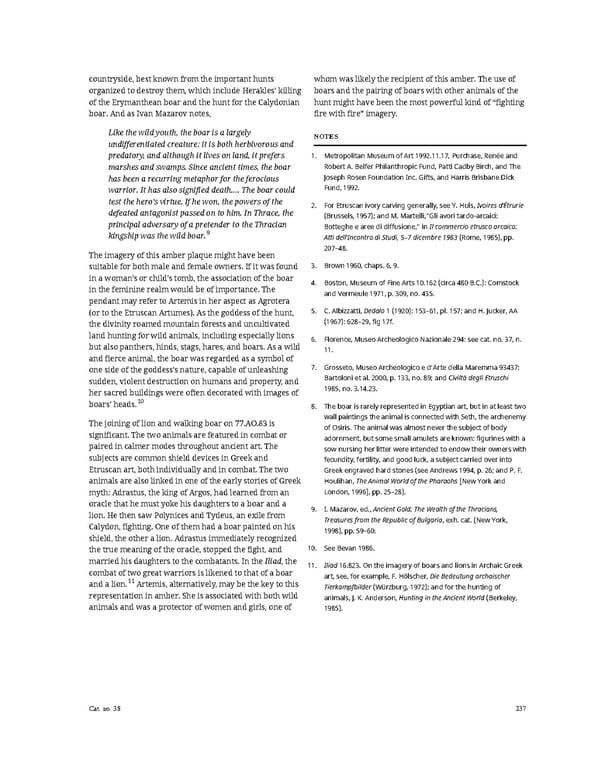countryside, best known from the important hunts whom was likely the recipient of this amber. The use of organized to destroy them, which include Herakles’ killing boars and the pairing of boars with other animals of the of the Erymanthean boar and the hunt for the Calydonian hunt might have been the most powerful kind of “fighting boar. And as Ivan Mazarov notes, fire with fire” imagery. Like the wild youth, the boar is a largely NOTES undifferentiated creature: it is both herbivorous and predatory, and although it lives on land, it prefers 1. Metropolitan Museum of Art 1992.11.17, Purchase, Renée and marshes and swamps. Since ancient times, the boar Robert A. Belfer Philanthropic Fund, Patti Cadby Birch, and The has been a recurring metaphor for the ferocious Joseph Rosen Foundation Inc. Gifts, and Harris Brisbane Dick warrior. It has also signified death.… The boar could Fund, 1992. test the hero’s virtue. If he won, the powers of the 2. For Etruscan ivory carving generally, see Y. Huls, Ivoires d’Étrurie defeated antagonist passed on to him. In Thrace, the (Brussels, 1957); and M. Martelli,“Gli avori tardo-arcaici: principal adversary of a pretender to the Thracian Botteghe e aree di diffusione,” in Il commercio etrusco arcaico: kingship was the wild boar.9 Atti dell’Incontro di Studi, 5–7 dicembre 1983 (Rome, 1985), pp. The imagery of this amber plaque might have been 207–48. suitable for both male and female owners. If it was found 3. Brown 1960, chaps. 6, 9. in a woman’s or child’s tomb, the association of the boar 4. Boston, Museum of Fine Arts 10.162 (circa 480 B.C.): Comstock in the feminine realm would be of importance. The and Vermeule 1971, p. 309, no. 435. pendant may refer to Artemis in her aspect as Agrotera (or to the Etruscan Artumes). As the goddess of the hunt, 5. C. Albizzatti, Dedalo 1 (1920): 153–61, pl. 157; and H. Jucker, AA the divinity roamed mountain forests and uncultivated (1967): 628–29, fig 17f. land hunting for wild animals, including especially lions 6. Florence, Museo Archeologico Nazionale 294: see cat. no. 37, n. but also panthers, hinds, stags, hares, and boars. As a wild 11. and fierce animal, the boar was regarded as a symbol of one side of the goddess’s nature, capable of unleashing 7. Grosseto, Museo Archeologico e d’Arte della Maremma 93437: sudden, violent destruction on humans and property, and Bartoloni et al. 2000, p. 133, no. 89; and Civiltà degli Etruschi her sacred buildings were often decorated with images of 1985, no. 3.14.23. boars’ heads.10 8. The boar is rarely represented in Egyptian art, but in at least two The joining of lion and walking boar on 77.AO.83 is wall paintings the animal is connected with Seth, the archenemy significant. The two animals are featured in combat or of Osiris. The animal was almost never the subject of body adornment, but some small amulets are known: figurines with a paired in calmer modes throughout ancient art. The sow nursing her litter were intended to endow their owners with subjects are common shield devices in Greek and fecundity, fertility, and good luck, a subject carried over into Etruscan art, both individually and in combat. The two Greek engraved hard stones (see Andrews 1994, p. 26; and P. F. animals are also linked in one of the early stories of Greek Houlihan, The Animal World of the Pharaohs [New York and myth: Adrastus, the king of Argos, had learned from an London, 1996], pp. 25–28). oracle that he must yoke his daughters to a boar and a 9. I. Mazarov, ed., Ancient Gold: The Wealth of the Thracians, lion. He then saw Polynices and Tydeus, an exile from Treasures from the Republic of Bulgaria, exh. cat. (New York, Calydon, fighting. One of them had a boar painted on his 1998), pp. 59–60. shield, the other a lion. Adrastus immediately recognized the true meaning of the oracle, stopped the fight, and 10. SeeBevan 1986. married his daughters to the combatants. In the Iliad, the 11. Iliad 16.823. On the imagery of boars and lions in Archaic Greek combat of two great warriors is likened to that of a boar art, see, for example, F. Hölscher, Die Bedeutung archaischer and a lion.11 Artemis, alternatively, may be the key to this Tierkampfbilder (Würzburg, 1972); and for the hunting of representation in amber. She is associated with both wild animals, J. K. Anderson, Hunting in the Ancient World (Berkeley, animals and was a protector of women and girls, one of 1985). Cat. no. 38 237
 Ancient Carved Ambers in the J. Paul Getty Museum Page 246 Page 248
Ancient Carved Ambers in the J. Paul Getty Museum Page 246 Page 248